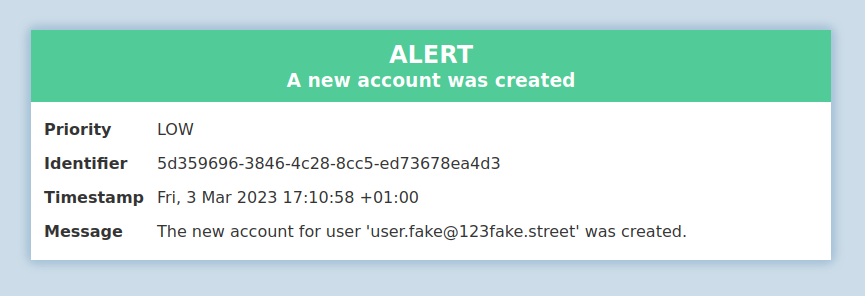Default channel types
Several default alert channel implementations are provided out-of-the-box by the alertingImpl component in the
alerting-component-default expansion resource (which is also included in the alerting-component resource). As these
implementations are addons that process routed alerts, it just has to be added as a dependency of the application. No
other component should depend on alertingImpl. All resolution of the channels is implemented by the expanders based on
the presence of these channel types in the application.
EmailChannel
The email channel type implemented by alertingImpl::EmailChannel is a channel type that sends alerts over email to a
recipient. Every recipient email address is considered to be an individual channel. The implementation of this channel
type uses the default JEE mailing system, so the majority of the configuration of the email server is done in the
tomee.xml file of the application server as data sources. The resolution of this configuration is done dynamically
based on the resource name. So multiple email servers can be configured if needed. This channel has full support for
UTF-8 in email body, sender name and recipient name.
The name field is the functional key of this channel and used to reference it from SubscriptionRoute. The config
field has the option alert.configName, so it is used to store the key
for the config properties group in the alerting.ns.properties file. The emailAddress field (required) contains the
email address of the recipient and the recipientName field (required) contains the name of the recipient.
The properties for this channel have the following keys:
from.email(required): Sender email address.from.name(required): Sender name.mailSession(required): Identifier of the mail session resource intomee.xmlthat should be used.template(optional): The string template that should be used to generate the body of the email. (Default:/net/democritus/alerting/impl/alerts/alert_email_body.stg)
alerts.emailChannel.default.from.email=noreply@example.com
alerts.emailChannel.default.from.name=Spammer1337
alerts.emailChannel.default.mailSession=mailSession_1
To use this properties group, the config field of a channel would have the value default.
Templating
An alternative template can be supplied by setting the template property to the resource path of a new stg file. Aside
from the default mappings, the EmailChannel also adds the following mappings:
channel.recipient: Maps to the name of the recipient as set inEmailChannel.recipientName.
Default template
The default email template will look something like this:

Depending on the alert priority, the color of the header will change:
- NONE
- LOW
- MEDIUM
- HIGH
- CRITICAL
SlackChannel
The Slack channel type implemented by alertingImpl::SlackChannel is a channel type that sends alerts over
Slack to a channel (a channel can also be a user channel). All configuration of this channel type
is done through the alerting.ns.proprties file and the DataElement itself.
The name field is the functional key of this channel and used to reference it from SubscriptionRoute. The config
field has the option alert.configName, so it is used to store the key
for the config properties group in the alerting.ns.properties file. The channel field (required) contains the
channel identifier of the Slack channel that the alert should be sent to. The channel identifier can be found by opening
the channel details page for a channel, where the identifier is shown at the bottom. To send a notification to a user,
use their member ID instead. This can be found in the additional options menu on their profile.
The properties for this channel have the following keys:
apiToken(required): The Slack API token for the Slack application to send notifications with. This should be a bot token, which starts withxoxb-.template(optional): The string template that should be used to generate the body of the email. (Default:/net/democritus/alerting/impl/alerts/alert_slack.stg)
alerts.slackChannel.default.apiToken=xoxb-my-token-here
To use this properties group, the config field of a channel would have the value default.
Templating
An alternative template can be supplied by setting the template property to the resource path of a new stg file. Aside
from the default mappings, the SlackChannel does not any additional mappings.
Default template
The default Slack template will look something like this:


PushoverChannel
The Pushover channel type implemented by alertingImpl::PushoverChannel is a channel type that sends alerts over the
Pushover notification service, which is a service to send push notifications to a mobile app
using a web API. All configuration of this channel type is done through the alerting.ns.proprties file and the
DataElement itself.
The name field is the functional key of this channel and used to reference it from SubscriptionRoute. The config
field has the option alert.configName, so it is used to store the key
for the config properties group in the alerting.ns.properties file. The targetKey field (required) contains the
key of the Pushover channel which an alert should be sent to. This can be either a user key to directly push to a user
or a group key to push to a delivery group.
The properties for this channel have the following keys:
appToken(required): The application token that is generated by Pushover for the application that must be registered to send push notifications through the API. Each application should be registered separately, so notifications from different applications can easily be identified.
alerts.pushoverChannel.default.appToken=123thisIs4tOken
To use this properties group, the config field of a channel would have the value default.
Implementation
The PushoverChannel does not currently use the templating engine, as Pushover offers an API with specific fields to provide. Though the message itself can be formatted, this was excluded for simplicity.
The alert priorities are mapped to Pushover priorities as follows:
| AlertPriority | Pushover |
|---|---|
CRITICAL | EMERGENCY |
HIGH | HIGH |
MEDIUM | NORMAL |
LOW | LOW |
NONE | LOWEST |
LoggingChannel
The Pushover channel type implemented by alertingImpl::LoggingChannel is a very simple channel type that writes alerts
to logs. This is mainly intended to test and debug the setup of the alerting component. It has no configuration other
than the channel name fields, which is the functional key of this channel and used to reference it from
SubscriptionRoute.
Implementation
The alert priorities are mapped to logging severities as follows:
| AlertPriority | Severity |
|---|---|
CRITICAL | ERROR |
HIGH | ERROR |
MEDIUM | WARNING |
LOW | INFO |
NONE | DEBUG |